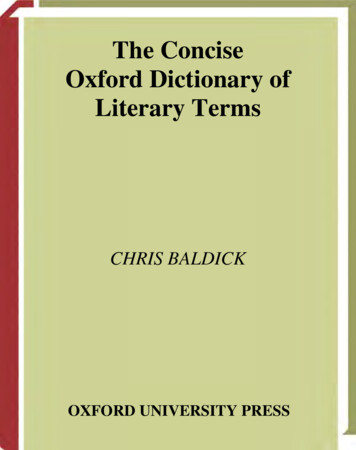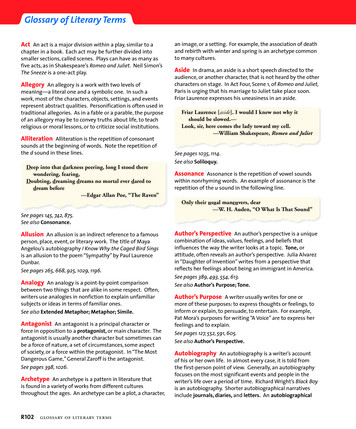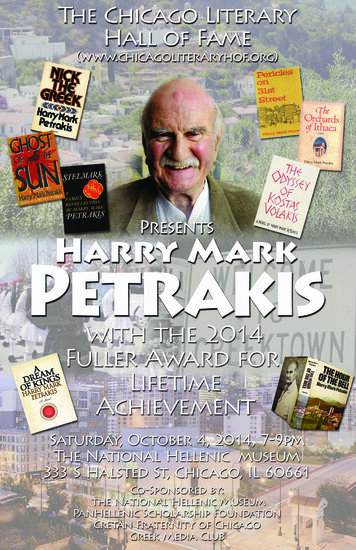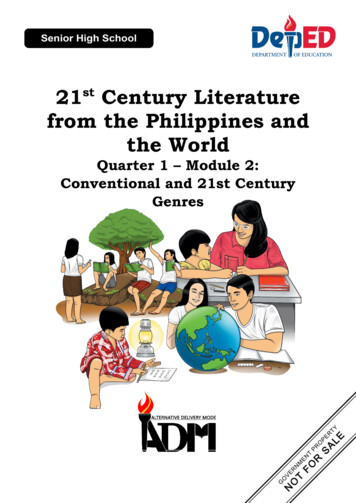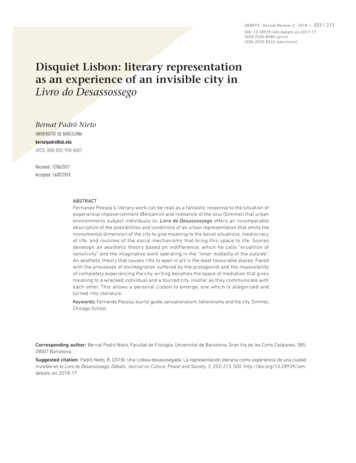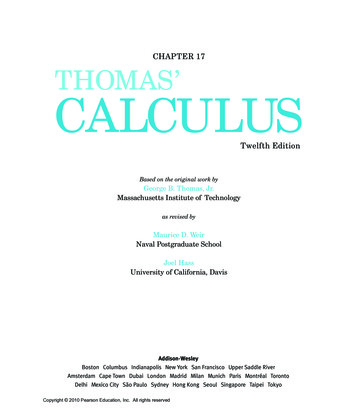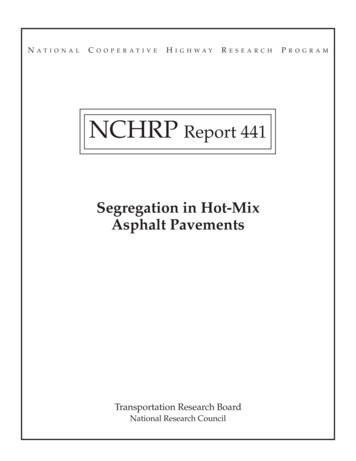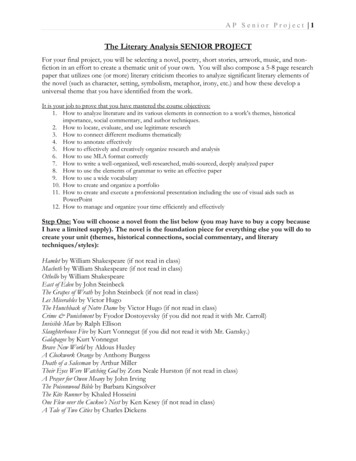
Transcription
AP Senior Project 1The Literary Analysis SENIOR PROJECTFor your final project, you will be selecting a novel, poetry, short stories, artwork, music, and nonfiction in an effort to create a thematic unit of your own. You will also compose a 5-8 page researchpaper that utilizes one (or more) literary criticism theories to analyze significant literary elements ofthe novel (such as character, setting, symbolism, metaphor, irony, etc.) and how these develop auniversal theme that you have identified from the work.It is your job to prove that you have mastered the course objectives:1. How to analyze literature and its various elements in connection to a work’s themes, historicalimportance, social commentary, and author techniques.2. How to locate, evaluate, and use legitimate research3. How to connect different mediums thematically4. How to annotate effectively5. How to effectively and creatively organize research and analysis6. How to use MLA format correctly7. How to write a well-organized, well-researched, multi-sourced, deeply analyzed paper8. How to use the elements of grammar to write an effective paper9. How to use a wide vocabulary10. How to create and organize a portfolio11. How to create and execute a professional presentation including the use of visual aids such asPowerPoint12. How to manage and organize your time efficiently and effectivelyStep One: You will choose a novel from the list below (you may have to buy a copy becauseI have a limited supply). The novel is the foundation piece for everything else you will do tocreate your unit (themes, historical connections, social commentary, and literarytechniques/styles):Hamlet by William Shakespeare (if not read in class)Macbeth by William Shakespeare (if not read in class)Othello by William ShakespeareEast of Eden by John SteinbeckThe Grapes of Wrath by John Steinbeck (if not read in class)Les Miserables by Victor HugoThe Hunchback of Notre Dame by Victor Hugo (if not read in class)Crime & Punishment by Fyodor Dostoyevsky (if you did not read it with Mr. Carroll)Invisible Man by Ralph EllisonSlaughterhouse Five by Kurt Vonnegut (if you did not read it with Mr. Gansky.)Galapagos by Kurt VonnegutBrave New World by Aldous HuxleyA Clockwork Orange by Anthony BurgessDeath of a Salesman by Arthur MillerTheir Eyes Were Watching God by Zora Neale Hurston (if not read in class)A Prayer for Owen Meany by John IrvingThe Poisonwood Bible by Barbara KingsolverThe Kite Runner by Khaled HosseiniOne Flew over the Cuckoo’s Nest by Ken Kesey (if not read in class)A Tale of Two Cities by Charles Dickens
AP Senior Project 2For Whom the Bell Tolls by Ernest HemingwayThe Stranger by Albert CamusThe Color Purple by Alice WalkerJane Eyre by Charlotte BronteThe Awakening by Kate ChopinThe Catcher in the Rye by J.D. SalingerHeart of Darkness by Joseph ConradFrankenstein by Mary ShelleyBy special permission:The Divine Comedy by Dante AlighieriThe Brothers Karamazov by Fyodor DostoyevskyMy Name is Asher Lev by Chaim PotokBeloved by Toni Morrison (challenging, anachronistic, symbolic ghost story)Cat’s Cradle by Kurt VonnegutA Farewell to Arms by Ernest HemingwayThe Sun Also Rises by Ernest HemingwayCeremony by Leslie Marmon SilkoPortrait of the Artist as a Young Man by James JoyceThe Great Gatsby by F. Scott FitzgeraldMurder in the Cathedral by T.S. EliotThe Cocktail Party by T.S. Eliot (if not read in class)The Winter of Our Discontent by John SteinbeckThe Metamorphosis by Franz Kafka (must be compared and contrasted with another short story, novel,or drama)The Lone Ranger and Tonto Fistfight in Heaven by Sherman AlexieGulliver’s Travels by Jonathan SwiftUncle Tom’s Cabin by Harriet Beecher StoweCatch-22 by Joseph HellerGeorge Washington Gomez by Americo ParedesThe Souls of Black Folk by W.E.B. DuBoisStep Two: Choose a literary criticism theory to apply to your novel. You may need to research thehistorical background and author’s information related to the novel, so that you can come up withimportant themes, historical ideas, and information about the author that can lead to a moreinformed understanding of why and how the work was written. You may benefit from researchingmore about a particular literary criticism theory. (Remember the Dorian Gray presentations?) Printout and annotate every bit of research you find. You should have a minimum of three credible,academic sources. You may not use Cliff’s notes, sparknotes, shmoop, blogs, onlineencyclopedias (Wikipedia), student papers found online, etc. You may, however, use someof these sources to launch a search for credible sources. You must also create an annotatedbibliography for each of these sources (see sample on pp. 5-8). As you annotate, use threedifferently colored pens to annotate: one color for all vocabulary and definitions (including termsand ideas you are unfamiliar with); one color for questions; and one color for connections, themes,historical ideas, social commentary, and literary techniques. Create a key for your instructor tofollow and stay consistent with your color-coding.If you are exploring a formalist, biographical, or historical approach, you may wish to focus yourpreliminary research on answering questions like:
AP Senior Project 3oooooooooWhat is the setting of this novel? Why did the author set it in that time period?How does that time period relate to issues brought up in the book?What was happening in the world during this time period? Is that relevant to the content?Why did the author write this book?Are there any interesting facts about the author’s life that might help you understand thenovel?What ideas or beliefs does the author hold? What philosophical, religious, and/or culturalbeliefs or ideas are espoused by the author and which are criticized throughout the novel?Is there anything typical about the genre of your novel?What are some common themes or ideas that are encountered in books like this?What are the common literary techniques and styles found in most novels of this time periodor genre?Step Three: Develop a format for a reading journal based on your preliminary research. In otherwords, look for the things that you learned about the novel prior to reading it, so that you can have afocus for your journal while you are reading that novel. The reading journal, of course, is thefoundation for your final essay focus. The more ideas you investigate for your reading journal, themore choices you will have for your final essay. YOU MUST HAVE A MINIMUM OF 30COMPLEX AND PROFOUND ANALYTICAL ENTRIES THAT FOCUS ON THESIGNIFICANT INFORMATION YOU DISCOVER WHILE YOU READ THE NOVEL ANDCOMPLETE YOUR RESEARCH. Also keep a vocabulary log. Choose 30 words to define anduse in a sentence of your own. You have control over how useful this is to you. Choose frequent,loaded, or challenging words and expand your vocabulary! It can also give you more detailsregarding the author’s style.Step Four: Draft a working thesis statement and an outline of the logical progression of ideas foryour final paper. Your working thesis statement should express a universal theme from the novel ordrama you have read. Then, think of instances in the novel or play that support your chosen theme.These will become the Roman numerals for your essay outline. (See the example below on p.9.)Step Five: Write an essay (5-8 pages) in MLA format with a works cited page (with the sources youaccessed throughout the entire project, including the preliminary research you did prior to reading)and internal citations addressing all that you have learned about this book and the related readings.Your essay must include a literary analysis of the novel using at least one approach to literarycriticism that we have covered in class and how the aids in the development of a universal theme.You need at least three research sources: these sources can be those you used as primary research,but they are not the related readings. Since you are creating the actual writing prompt for thisessay, you need to be sure you have a really strong thesis and intro paragraph that make that promptand the purpose of your essay clear to me. You should have at least three embedded quotes fromthe novel or from your research in each paragraph. Your essay is a literary analysis paper primarily(not a historical analysis paper), so the historical or other source information you use in your essay isthere to provide support for your literary analysis. You will not need to use the art or music in youressay unless it is relevant historically or as a direct representation of the novel. If you do choose toinclude some analysis on music or artistic pieces, they can be analyzed using the same tools we applyto literature. If you embed an image into your paper, there still needs to be a minimum of five pagesof written analysis. A completed paper will be due . This draft will receive an APrubric score and feedback. You will have a chance to revise your essay and turn that in with yourportfolio.
AP Senior Project 4ANY ESSAY WITHOUT A WORKS CITED PAGE OR INTERAL CITATIONSOR THAT IS FEWER THAN FIVE COMPLETE PAGES WILL NOT BEGRADED.Step Six: Develop a thematic unit topic. Find other art, poetry, non-fiction, music, and shortstories that fit into this thematic unit as if you were teaching this novel as part of a thematicunit to a high school English class. You will need at least two poems, two short stories and/ornon-fiction pieces, and two pieces of art (paintings, sculpture, film, music, etc.) that relate directlyto the novel thematically or historically. You may find some of these related readings in your purplelit book. You must then annotate these pieces in a manner of your choosing that clearly illustrateswhy you chose them and how they are relevant to your novel and overall thematic unit (in terms ofthe historical ideas, the societal commentary, the use of literary techniques and styles, etc.). You mayreference some of these pieces in your actual essay if they serve to introduce, illustrate, or explainyour thesis. Please type your annotations on a separate sheet of paper if you cannot handwritelegibly. Finally, draft a Proposal Letter (see p. 11 below) explaining the unit theme you wouldinclude this novel in and briefly explain what works you have chosen to include in the unit. If youwere teaching this novel to high school students, why would you include these other related piecesof poetry, art, non-fiction, etc.?Step Seven: Build your portfolio.Obtain a new three-ring binder for your essay, your annotated bibliographies, your reading journaland vocab log, your proposal letter, and copies of all of your research, poems, non-fiction, art, shortstories, and everything else you have come up with over the course of this assignment. (See therubric below.)IF A PORTFOLIO IS TURNED IN WITHOUT AN ESSAY, NO POINTS WILLBE GIVEN TO THE ENTIRE PROJECT.How will you be graded?1. Your essay will receive a grade based on the 9-point AP scale. Significant errors in grammarmechanics (more than four errors per page), MLA formatting, and essay formatting willresult in a grade penalty. It is expected that you will exhibit proficiency in embedding quotesand paraphrasing sources as well as utilizing legitimate sources to support your essay focusand analysis. (Using a legitimate source once is not enough.)2. Your annotations will be graded based on effort, depth and complexity, thoughtfulness ofthe comments, and the significance of the thematic, historical, social, political, religious, andliterary connections. IT IS IMPERATIVE THAT I CAN READ YOURANNOTATIONS, OR YOUR GRADE WILL SUFFER.3. Your reading journals will be graded on the effort, the critical thinking, the depth of analysisof the novel, the organization of the log, and your choice of focus topics.4. Your research will be graded on your ability to choose legitimate sources, use themeffectively in your paper, and annotate those sources in deep and meaningful ways.5. Your portfolio will be graded on your organization, completion, and presentation.
AP Senior Project 5Due DatesBetween 11/20-2/29Choose and Read a Senior Project NovelOn or before Feb. 5Annotated Bibliographies (100 pts.)On or before February 29Working Thesis Statement & Outline (100 pts.)On or before March 21Reading Journals (90 pts.) and Vocab Log (60 pts.)On or before April 8Initial Draft of Final Paper (10 Writing pts.)On or before May 13Final Portfolios (300 Misc. pts.) w/ revised essay (30 Writing pts.)UNLESS MODIFIED BY THE TEACHER, THESE ASSIGNMENTS ARE DUE NO LATERTHAN 2:00pm ON THE DUE DATE SPECIFIED AND SHOULD BE HANDED DIRECTLY TOYOUR ENGLISH TEACHER.LATE WORK WILL BE ACCEPTED FOR ½ CREDIT FOR ONE WEEK ONLY (TIMEPERMITTING). AFTER THE ONE WEEK GRACE PERIOD, NO LATE WORK WILL BEACCEPTED.Annotated BibliographyAn annotated bibliography includes an MLA Works Cited page listing of your sources (checkout citationmachine.net) followed by a summary, evaluation, and/or reflection of each of thosesources. The purpose of the annotated bibliography is to inform your professor of the relevance,accuracy, and quality of the sources cited. Depending on your project or the assignment, yourannotations may do one or more of the following: Summarize: Some annotated bibliographies merely summarize the source. What are themain arguments? What is the point of this book or article? What topics are covered? Ifsomeone asked what this article/book is about, what would you say? What insight does itprovide on your novel? What is it helping you to look for or think about?Evaluate/Assess: You need to legitimize your source for your teacher/professor. Is theinformation reliable? Is this source biased or objective? Is the author qualified in his/herfield of study? Is the publisher reliable and qualified? Does the source offer a works citedpage or other bibliographic information?Reflect: Once you've summarized and assessed a source, you need to ask how it fits intoyour research. Was this source helpful to you? How will it help you shape your analysis?How can you use this source in your paper? How does it compare with other sources inyour bibliography? This is the place where you need to specifically explain the way thesource actually addresses your research question/topic.
AP Senior Project 6Your college annotated bibliography may include some of these, all of these, or evenother elements. If you're doing this for a class, you should get specific guidelines fromyour instructor.Here are some samples of annotated bibliographies that cover all three of theelements above. This should be typed in a 12 point font, Times New Romanwith regular margins.Gallagher 1Havanna GallagherMr. BodellAP English IV, per. 613 February 2015Annotated Bibliography #1Rosenbaum, Ron. "He’s Not Holden! The One Big Mistake People Make About Catcher in theRye." 12 Sept. 2013. Web. 06 Feb. 2015.Ron Rosenbaum’s article “He’s Not Holden!” tells his readers that J.D. Salinger is not the maincharacter in his novel, The Catcher in the Rye, and that Holden Caulfield is a satirist who hates phonies.Rosenbaum makes the point that readers of Salinger should not look to far into the text and it’s author andthat the work should speak for itself not the author. He believes that characters are supposed to bedifferent from the author: maybe someone they wish to be. He thinks that making a novel too complicatedonly diminishes the meaning. He begins to talk about Salinger’s characters and how they may not relate toSalinger, but they do relate to the young women he has dated. According to Rosenbaum, readingSalinger’s work from different perspectives is the only way to create a full understanding of who Salingeris.The publisher Slate is a pretty good source and the article has its own works cited page, so that Icould make sure the information was credible. Rosenbaum is an author himself and is noted in manysources like the Smithsonian and in magazines. The source is slightly biased because he is a fan of
AP Senior Project 7Salinger’s work and believes that everyone should have the same understanding as him. He graduatedfrom Yale University and there he studied literature. He has the credentials for writing and although he’svery opinionated, he makes some good points and he has facts to back them up.This article is a good source for my research because it creates another perspective following theones from previous articles. There are those who criticize Salinger as a person and those who criticize himas an author and that can be very useful. Rosenbaum has information on how Salinger doesn't resemblehis characters in his novel and stories. Other people in his life may resemble the characters, but thereshouldn't be a hidden meaning. Salinger’s thirst for youth in his everyday life becomes useful whenanalyzing the questions from his novel. (more?!)Katherine WilcoxMr. BodellAP English IV-46 February 2015Annotated Bibliography #3McInnus, Gilbert. "Evolutionary Mythology in the Writings of Kurt Vonnegut Jr." Samizdat.Heldref Publications, 2005. Web. 05 Feb. 2015. 05 Feb. 2015. http://www.samizdat.qc.ca/arts/lit/vonnegut ev gm.htm .This article analyzes the role that evolutionary mythology plays in different Vonnegutbooks. It attributes that the “chance element” is the primary driving force that influences variouscharacters in different books. It claims that when there is the element of chance, there can be noGod and appoints natural selection as the “almighty power that governs humanity.” This articleclaims that Vonnegut is trying to inform readers of the chance element and “gambling-casinoluck” that influences the environment and society. When analyzing this article I primarily
AP Senior Project 8focused on the commentary for Galapagos and Slaughter House 5 since these are books I haveread and I feel that I understand.This source seems to be a credible source. The author McInnus has a PhD in EnglishLiterature. He just recently published a monograph of the Evolutionary Mythology in theWritings of Kurt Vonnegut. At the end of the website that has this article, McInnus provided along list of works that he consulted in his article.Despite this and his PhD in English, I do not agree with the majority of the analysis thathe has in this article. I think that the examples he used to support his claim of evolutionaryinfluence are stretched. I feel this way because when I read novels by Vonnegut it is not themesof evolution that pop out at me, but instead themes of human ignorance and destructiveness.McInnus claims that the chance element in natural selection is the “almighty power” that controlsthe fate of humanity. However, in the interview of Vonnegut that I listened to, Vonnegut claimedthat he did not completely believe in evolution creating such intelligent creatures. Whenanalyzing Slaughter House 5 McInnus claims that the Tralfamadorians teach Billy about lifewithout a “beginning, middle, or end,” resulting in Billy’s belief that “chance rules supreme”.However, Vonnegut uses the Tralfamadorians as a way to satirize people who pass through lifeas if “trapped in amber” and not working to live life or stand up against human corruption. I donot agree with the majority of the analyses that McInnus makes, and will not use it to support mybook. I will instead use Galapagos to rebuttal claims that are made in this article that I do notagree with and that Vonnegut probably does not agree with.
AP Senior Project 9RESEARCH PAPER OUTLINE EXAMPLEMake it easier for yourself and include citations with the ideas you plan to use!Student 1Awesome StudentMr. BodellAP English IV, per.29 February 2016Working Title: Trying to Catch HimselfTHESIS QUESTION: How does Salinger develop the universal theme that people often feel ruined and longfor innocence?THESIS STATEMENT: J.D. Salinger employs an unusual protagonist and extensive symbolism throughouthis coming-of-age novel The Catcher in the Rye to expose the often concurrent human desires for innocenceand acceptance amidst universal human fears of failure, inadequacy, rejection, and death.I. Unreliability of narrator and Caulfield’s fear of rejection. (Psychoanalytical Criticism)A. The unreliability of Salinger’s narrator, Holden Caulfield, presents an interesting psychologicalstudy for avoidance behavior and distrust, and these coping mechanisms serve to exposeCaulfield’s fear of rejection for being who he really is. (Topic Sentence)1.The dangers of avoidance behavior (Howe)2.How Caulfield manifests this.B. Caulfield also manifests post-traumatic disorder in the way that he 1.Post-traumatic stress disorder with loss of brother (Erlich).3.This expresses Caulfield’s own desire for innocence and a return to some kind of purityin his pining to return to the way things wereII. The pond with the ducks representing III. The unchanging museumIV. The encounter with the prostituteV. Holden imagining himself to be “the catcher in the rye”VI. Conclusion
A P S e n i o r P r o j e c t 10Henry 1Sample Works CitedAdams, Joe. "How to Make Vegetarian Chili." eHow.com. eHow, n.d. Web. 24 Feb.2009. (web page)"The Blessing Way." The X-Files. Fox. WXIA, Atlanta. 19 Jul. 1998. Television.Brubaker, Bill. "New Health Center Targets County's Uninsured Patients." WashingtonPost 24 May 2007: LZ01. Print. (newspaper)Buchman, Dana. "A Special Education." Good Housekeeping Mar. 2006: 143-8. Print. (magazine)Foo Fighters. In Your Honor. RCA, 2005. CD. (music)Gleick, James. Chaos: Making a New Science. New York: Penguin, 1987. Print. (book)Goya, Francisco. The Family of Charles IV. 1800. Museo del Prado, Madrid. (art)Harris, Muriel. "Talk to Me: Engaging Reluctant Writers." A Tutor's Guide: HelpingWriters One to One. Ed. Ben Rafoth. Portsmouth, NH: Heinemann, 2000. 24-34.Print. (Works in an anthology or collection)New American Standard Bible. Ed. Susan Jones. New York: Doubleday, 1985. Print. (bible)Purdue, Pete. Personal interview. 1 Dec. 2000. (personal interview)The Usual Suspects. Dir. Bryan Singer. Perf. Kevin Spacey, Gabriel Byrne, ChazzPalminteri, Stephen Baldwin, and Benecio del Toro. Polygram, 1995. Film.(video)(The bolded words at the end of each entry in parentheses are NOT part of the actualworks cited entry. These are just for your information.)Note the Alpha-sorting! Need help with this stuff? citationmachine.net is pretty good.Your paper must have a Works Cited to be graded! It should be the last page of your paper(page 6-9). Your paper must correctly cite the sources you use as well. If your paper isplagiarized, you will receive a zero per Serrano’s 12th grade English policy.
A P S e n i o r P r o j e c t 11Senior Project Proposal Letter ExampleType in Times New Roman or Garamond, 12 point font with 1” marginsYour NameP.O. Box 292222Phelan, CA 92392-2222(760) 555-1212[Your address and phone number][Space]May 13, 2016[Space]Mr. Matthew BodellSerrano High SchoolP.O. Box 296000Phelan, CA 92329-6000[Address to your own English teacher][Space]Dear Mr. Bodell:[Space]In the first paragraph, introduce your thematic unit. Then, introduce the novel you have selectedto anchor your thematic unit upon. How does this novel fit this thematic unit idea?[Space]In the second paragraph, introduce at least two pieces of poetry that you would use if you wereteaching this novel to high school students. Why would you include these poems? Explain theconnections to the theme or the time period or the relationship the poem might have to the novel.How would these poems help to understand the novel? How would they help understand thebroader theme?[Space]In the third paragraph, discuss at least two of the non-fiction pieces and/or short stories youchose and explain their relevance or significance to the theme.[Space]In the fourth paragraph, introduce the artistic pieces you would include in this thematic unit.What pieces would you include? List them and discuss their relevance just like you did for thesecond paragraph. These could include paintings, sculptures, musical pieces, and even film.[Space]In the final paragraph, discuss the resources that you found to be the most helpful in organizingyour thematic unit. Argue for or against using this unit in an actual AP English class. Do youthink the novel and theme would fit well into the curriculum? Do you think students would bereceptive to it? Or do you think this novel is still better left to be an independent, self-guidedseminar novel for AP students to choose from during second semester?[Space]Sincerely,[Four Spaces]Your handwritten signatureYour name typed as written above.
A P S e n i o r P r o j e c t 12AP Portfolio Grading RubricYour Completed Portfolio is due on or before May 18th.All items required for completion and this rubric must be included in the portfolio on the due date.Standard late work policy is in effect: ½ off for 5 days, 0 credit after 6 days or more.Writing1. Final Draft of your essay with Works Cited PageRubric Score/20MLA (Page format, citations, W.C. page)Source Use (at least 3 credible sources used)/42. Rough Draft w/ rubric/33. Annotated Bibliographiesw/ annotated articles/3Reading Journals4. Reading Journals for novel (30 entries)5. Vocab Log (30 words)/30/90/60graded/150Misc.6. Proposal Letter for Thematic Unit7. At least 2 Poems annotated8. At least 2 annotated Short Story or N.F piecew/ at least 5 RJ style entries10. At least 2 Pieces of Art annotated/100/20/20/20/20Portfolio organization A new binder with a creative cover and/20 A creative title that accentuates your thematic unit Your name, the date, your instructor’s name, and the course name Section dividers for each of the numbered items on this rubric Everything is in the order of this rubric, and please don’t put a bunch of items in one plastic sheet which wouldrequire me to pull them out to read them. Do not put your essay in plastic.Overall Performance on this Senior ProjectMastery of objectives is clearly exhibitedComplexity and depth is clearly exhibitedThorough understanding of topics is clearly exhibitedEffort expended is clearly evident - Challenge is obviousDegree of critical thinking skills is clearly exhibited/100/300
academic sources. You may not use Cliff's notes, sparknotes, shmoop, blogs, online encyclopedias (Wikipedia), student papers found online, etc. You may, however, use some of these sources to launch a search for credible sources. You must also create an annotated bibliography for each of these sources (see sample on pp. 5-8). As you annotate .




